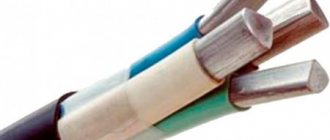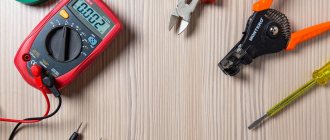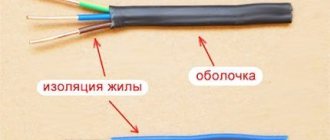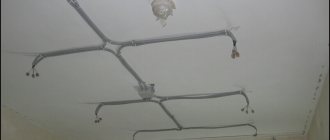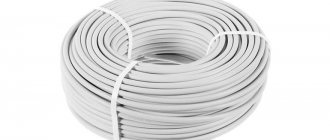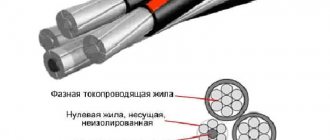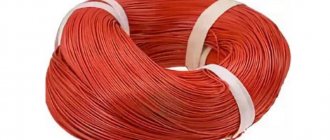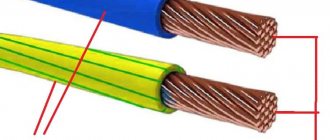An electrical cable is the main element of the electrical network, which is always laid during the construction of a house. After all, without it, not a single electrical appliance in the building will work. In order to carry out installation work correctly, you need to know which wire to use for wiring in the house. For this reason, we will first talk about the design features of a modern electrical cable, and also consider its popular types, and how to choose the cross-section of the wire for your home.
Layed wire under the ceiling of a house Source sense-life.com
Design features of the electrical wire
The design of any electrical wire contains cores. These are the main elements of the cable. Each of them has a shell. It is internal insulation. Current is transmitted directly through the veins. Any number of them is contained in a common outer protective shell. The number of cores is always taken into account when deciding which cable to choose for wiring in the house.
In addition to current-carrying elements, their insulating protection, and the outer sheath, the design of an electrical cable may also contain additional components. For example, this is the internal common shell. It is located in the wire between the outer protective layer and the insulated conductors. The electrical cable may also have armor made of wire or steel.
Structure of an electrical cable Source elektrikii.ru
Manufacturers produce electrical wires with cores that can be solid single-wire. Cables consisting of multi-wire conductive elements are also produced. Such veins are made from a large number of thin threads.
Important! Do not confuse a single-core electrical wire with a single-wire conductive element. After all, a single core in an electrical cable can consist solely of one or several wires twisted together.
Professionals choose electrical wiring for their home based on their experience. They take into account the level of ease of working with it. Experts also take into account what material the electrical cable cores are made of. After all, manufacturers make conductive elements of electrical wires from aluminum or copper.
When comparing these metals, it is noted that aluminum conductors make it possible to produce cheaper cables. However, such wires are characterized by lower electrical conductivity. Therefore, with the same cross-sections, copper wires will pass more electric current.
Wires with aluminum conductors have low electrical conductivity Source lomrf.ru
Copper wiring also has one disadvantage. It lies in the impossibility of a high-quality direct connection of copper with another metal. In other words, special adapters are used to connect copper and aluminum wiring. They are used to prevent the formation of a galvanic couple at the junction.
On a note! Experts believe that aluminum cables are not the best option for home electrical wiring. This is due precisely to their low electrical conductivity. In addition, electrical cables made of aluminum can quickly oxidize and break at bending points.
If wires made of different materials are twisted together, then oxidation of the junction will occur. Therefore, the contact between the electrical cables will disappear, which will lead to a short circuit in the electrical network.
Important! It is necessary to use the same type of wiring cable throughout the house.
Manufacturers produce wires with general protective insulation, for the manufacture of which the following is used:
- polyethylene;
- rubber material;
- polyvinyl chloride
Any cable for wiring in the house is produced with an outer sheath, which has high insulating properties. The outer braid provides reliable protection against water. Modern wires are used to create electrical networks of various classes with a maximum voltage of 500 V.
See also: Catalog of companies that specialize in electrical work of any complexity
Core material
Cables come with different core compositions - aluminum or copper. Copper ones are considered more reliable - they have lower resistance, oxidize more slowly, conduct current well, and are subject to repeated bending without damage.
- As for the design, the wires are single-core, with a cross-section formed by one conductor, and double-core, respectively, with a cross-section formed by several conductors, sometimes intertwined.
- Single-core cables can be used in apartments and houses to supply electricity to sockets, lighting lamps, etc.
- They are quite rigid and lack flexibility. Theoretically, this use of wire is permissible, because the plaster will serve as additional protection.
But long practice shows that the best option is soft and flexible multi-core cables.
Popular electrical cables for the home
When a specialist decides which cable to use for wiring in a house, he, first of all, focuses on existing types of wires. An important selection criterion is the number of cores required. Many manufacturers produce cables with 1-5 conductive elements. Such products have different purposes. Therefore, it is necessary to consider the main common types of wires for electrical wiring in private residential buildings.
Type 1 – VVG cable
When laying in-house electrical wiring, including installation of an electrical network using distribution boxes, VVG cable is often used. It is through it that current is transmitted. It can withstand a maximum voltage of 1000 V. Manufacturers produce this current conductor with cores, the number of which does not exceed 5 pieces.
Four-core electrical cable VVG Source files.glotr.uz
For VVG products the cross-section can be:
- flat;
- round;
- square;
- triangular.
The advantages of VVG electrical cables include the wide temperature range at which these products are used. For such current conductors it ranges from -50 to +50 ℃. Electrical wires of this type can withstand high breaking loads. They are also renowned for their ability to be used in environments that are 98% critical.
Electric cable VVG can be designated as follows:
- NG – insulating shell that does not support the combustion process;
- Z – the presence of rubber material or polyvinyl chloride bundles between the external protection and the insulated conductors;
- P – flat wire.
On a note! VVG cable for electrical wiring, with the exception of the wire with the letter “Z”, is manufactured without filling the space that is located between the insulated conductors and the external protection.
When creating home electrical lines, a wire marked VVGng-LS is often used. Such products meet all safety criteria and are sold at an affordable price. Its insulation contains a minimum of halogens. Therefore, the wire burns and smolders more slowly. This makes it possible to inhale less dangerous doses of toxic substances during a fire. In addition, people will be able to evacuate longer.
What characteristics of wires should you pay attention to?
We will talk about such home network transmitters as household power cables or wires with a voltage of 220/380 V.
So, the cable is characterized by the following components:
- Current-carrying conductor material (aluminum, copper, etc.);
- Constructive design (flat, round, etc.);
- Section;
- Voltage;
- Marking;
- Purpose of the product;
- Vein colors;
- Product certification and packaging;
- Product condition
Selection of wire cross-section
Manufacturers produce electrical cables exclusively with a standardized cross-sectional area. When choosing this parameter for any wire, the current strength in the electrical network is taken into account. It is also necessary to take into account the material of manufacture of the current-carrying conductors and the place where the wiring is installed. Experts never forget about the last point, because the electrical cable can get very hot.
On a note! There are cases when it is necessary to lay several very hot wires in one tray. In such a situation, mutual heating of conductive products reduces the permissible current strength to 30%.
In order to accurately determine what cross-section of wire to use for wiring in the house, you must first know the sum of the current values of all electrical appliances in the building. Therefore, it is important, even at the design stage of electrical wiring, to determine as accurately as possible the quantity and type of equipment used in the construction.
It is important to know as accurately as possible the number and parameters of the equipment used in the house in order to correctly calculate the cross-section of the electrical wiring Source imageban.ru
To calculate the required cross-section in mm², the power of all devices is usually first divided by the network voltage, which is 220 V. After this, it is taken into account that 1 mm² of copper electrical cable passes 10 A through itself, and 4-6 A from aluminum.
So, if an electrical appliance has a power of 4 kW, then the current will be 18.18 A. To calculate this value, you only need to divide 4000 W by 220 V. To connect an electrical appliance with this power, you will need to use an electrical cable with copper conductors, whose cross-section is 1.8 mm².
It is recommended to increase the calculated value by 1.5 times. This action is performed for safety reasons. Taking into account the margin for the example under consideration, it is necessary to use an electrical wire with copper conductors whose cross-section is 2 mm². If you choose an aluminum cable, then you will have to purchase a wire whose conductive cores will be 2.5 times thicker.
Product packaging and certificates of conformity
According to cable standards, cables are packaged in coils or drums. The coils are delivered to special stores, the drums are picked up by traders, construction workers and other buyers of this rank.
It is mandatory to have a tag containing the following information:
- The name of the manufacturer or its trademark;
- Product labeling;
- GOST or TU;
- Date of issue;
- Coil or drum number;
- Quality control mark with seal;
- Number of segments and their length;
- Conductor weight;
- Mark of conformity
The certificate is a guarantee of the quality and reliability of the purchased product. Usually a product has two of them - a certificate of conformity and a fire safety certificate.
You can familiarize yourself with them immediately upon purchase. The documents must indicate GOST standards and the expiration date of the goods.
Briefly about the main thing
Electrical cables are made with cores that are usually made of copper. However, there are also electrical products with conductive elements made of aluminum. The design of any electrical wire also includes an outer sheath and insulation of each core. Perhaps there is also an internal common shell and armor in the form of a metallized layer.
In homes, VVG and NYM wires are most often used. Less commonly used is PUNP electrical cable, which is of lower quality. Experts recommend using VBBShV electrical products in the ground. This is an armored wire.
The cable cross-section is determined by the current strength. To calculate it, divide the power of electrical appliances by the network voltage. In this case, it is additionally taken into account that 1 mm² of copper wire can pass 10 A.
How to choose a cable?
When choosing a cable, you need to consider the number of cores. In this case, the determining factor is the presence of grounding in the building.
If the building is equipped with grounding, then the issue is resolved clearly in favor of a three-core cable. Despite the higher cost compared to the two-wire option, it is better not to neglect the additional opportunity to enhance the safety of the operation of electrical appliances.
It makes sense to lay a two-core cable in cases of replacing old wiring. The absence of a ground wire in old electrical lines makes the use of an expensive three-core cable pointless.
Another point that you need to pay attention to when choosing cables for lighting is the design characteristics of the conductor itself. It can be solid or consist of several thin wires. In the latter case, the cross-section is determined by the sum of the areas of each wire.
Cable products with stranded conductors are more flexible, which makes them easier to install in hard-to-reach places in residential premises, in particular in suspended ceiling structures and when installing hidden wiring in thick concrete floors. In the technical characteristics of the product, this is reflected in the multiplicity of the radius of the internal bending curve of the core in relation to the diameter.
Types of home wiring
There are two types of home wiring: open and hidden. For residential premises, hidden installation is most often used. Open wiring can be used in the country, in private and country houses, various outbuildings and utility rooms.
Open wiring
This type of gasket attracts with its simplicity. You can easily change the direction of the cable, repair it or perform other work. However, such a line will not look aesthetically pleasing and will most often be less safe.
Hidden wiring
It looks neat, it is not visible, it has a longer service life, the cable is protected from mechanical influences and natural factors. More difficult to install, repair and maintain. Also, a hidden electrical wire may be accidentally damaged when performing other work involving drilling or drilling holes.
Special cases of lighting arrangement
Separately, it is worth considering certain options for arranging lighting for non-residential objects. They have their own specifics.
Bath and sauna
Washing rooms are characterized by high humidity, so laying electrical lines in metal pipes and hoses is prohibited because of their tendency to corrosion. The steam rooms of baths and saunas also have a high temperature, and electrical wiring in them is allowed only with heat-resistant cables and wires:
- RKGM;
- PRKA;
- PRKS;
- PMTC.
Heat-resistant wire RKGM in rubber insulation.
You can also use foreign-made OLFLEX HEAT 205, but it is more expensive.
Installation of switches
One of the basic rules in installing any type of switch, lighting or automatic, is that it is always placed on a phase wire. It would seem that what a difference it makes - after all, if you install a switch on the neutral conductor, the circuit will still be open and the light will go out.
For an analogy, we can give an example with a water pipe: having turned off the tap, the would-be plumber begins to drill the pipe before the tap, and not after. As a result, a fountain of water will come out of the pipe, although not a drop will flow out of the tap.
Connecting wires inside a distribution box, when the power for sockets and lighting comes from one common cable
Wiring diagram for a chandelier with 5 bulbs and a two-key switch: 0 - zero; ph—phase; 1 - chandelier; 2 — connection box; 3 - two-key switch; 4 - connecting terminals
Example of using pass-through switches (switches)
Expert opinion
Viktor Pavlovich Strebizh, lighting and electrical expert
Any questions ask me, I will help!
After all, the rated currents of these switching devices are often forgotten when purchasing, which leads to their rapid failure, or even fire. If there is something you don’t understand, write to me!
